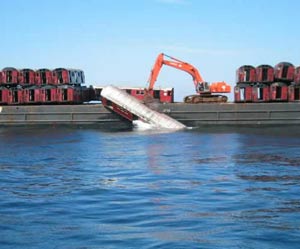Marine Artificial Reefs
What is an Artificial Reef?
To many saltwater fishermen and sport divers the term "reef" usually brings to mind a scene of a picturesque tropical coral reef with schools of brightly colored fish swimming through clear waters and a maze of intricate coral heads, swaying sea fans and large sponges. Large predatory fish such as grouper, barracuda and snapper hide in shadowy crevices or feed in wide open areas on the abundant supply of smaller fish and invertebrates on the reef. In this setting, both anglers and divers are able to harvest or simply observe a wide variety of animals from fish to lobsters, often within several hundred yards of shore.
While reefs such as this may be common in tropical climates throughout the world, they do not exist in the waters of the continental United States above the southern tip of Florida. Off the southeastern coastal states from North Carolina to Florida, this type of coral reef habitat is replaced by what biologists and fishermen term"hard-bottom" or "live-bottom" areas.

These more temperate reef communities occur only in specific locations on the ocean bottom where nature has provided a suitable hard substrate, usually in the form of limestone rock out-croppings, which serve as a point of attachment and colonization for sponges, corals and a wide assortment of other invertebrates. In some cases where significant rock is exposed through the otherwise sandy bottom, vertical relief and ledges add to the complexity of this habitat and provide additional space and homes for many other reef inhabitants.
While coastal live-bottom reefs are known for their productivity, and are therefore popular destinations for many recreational anglers and divers, they comprise only a small percentage of the ocean bottom accessible for sport fishing or diving. Off South Carolina, the majority of the continental shelf is covered with sand several feet deep, while only about 5 to 10 percent of the bottom has the appropriate geological makeup to allow for the formation of a reef community. This results in limited opportunities for fishermen and divers to pursue their interests, and leads to heavy utilization of some well-known hard-bottom areas along the coast.
To enhance recreational fishing and sport diving opportunities in coastal waters, and to increase the amount of productive hard-bottom habitat available overall, man can participate (with significant help from nature) in the creation of additional man-made, or "artificial" reefs. This is accomplished by placing suitable long-lived, stable and environmentally safe materials (usually steel or concrete) on a selected area of ocean bottom. Once the material is in place it acts in the same way that naturally occurring rock outcroppings do in providing hard substrate necessary in the basic formation of a live-bottom reef community.
Since there is nothing artificial about the myriad of living organisms which eventually colonize and inhabit almost every square inch of these man-made structures, the term artificial reef may really be somewhat misleading. When properly designed, located and constructed with an adequate quantity of stable and durable substrate, man-made reefs can be equally as productive in theory as naturally occurring hard- bottom habitats, limited only by the life-span of the materials utilized. Given the variety of materials currently in use on many artificial reefs, some reef structures in place now could remain productive for the next one to five hundred years.
South Carolina's Marine Artificial Reefs
Artificial reef development in South Carolina's coastal and offshore waters is managed through the South Carolina Department of Natural Resources, Marine Resources Division (MRD). The state's Marine Artificial Reef Program, first established in 1973, is a part of the MRD's Office of Fisheries Management (OFM). As of January 1996, the OFM held permits for the continued development of 38 artificial reef construction sites along the South Carolina coast. These sites are located in waters from 9 to 110 feet deep, ranging from inshore locations to areas as far as 35 miles offshore.
Individual reef construction sites range from small areas to one square mile in size, with multiple reef structures placed within the boundaries of each area. All sites are located on flat featureless sand bottom which offered little interest to divers or fishermen prior to the placement of reef materials. Reef construction sites are selected to provide easy access to users while attempting to avoid possible conflicts with any other use of the bottom or waters near the permitted areas. Most reef sites are buoyed to assist in their location.
South Carolina's marine artificial reefs are constructed from a wide variety of materials ranging from various forms of suitable scrap to specifically designed and constructed reef habitat structures. Steel-hulled vessels are the most commonly employed scrap material in reef construction, with over 100 having been sunk off the state since 1969. Other scrap materials recycled on South Carolina reefs include steel and concrete bridges, concrete culvert pipe, steel dry dock work platforms, ex-military aircraft and even intercontinental ballistic missiles.
Given the unpredictable availability of suitable scrap materials from year to year, artificial reef managers have begun to rely more heavily on designed reef habitat structures to carry out reef construction projects. The South Carolina Marine Artificial Reef Program is a leader in the design, testing and utilization of these artificial reef structures in the United States with over a dozen different designs of habitat units having been deployed and tested on its reefs since 1983.
Designed reef habitat units of various shapes and sizes are currently being tested at many nearshore and offshore locations. These designs incorporate standard construction materials such as steel, concrete and some heavy-duty plastics into easily deployable, cost-effective and biologically efficient forms of habitat substrate which often produce a better quality longer-lived reef than could be obtained through the use of some available forms of scrap. Future reef construction activities may rely much more heavily on these types of structures.
Artificial Reef Buoys

Most offshore artificial reefs are marked by yellow nun buoys with a 4-foot tall mast and radar reflector. These buoys are maintained by the Marine Resources Division to assist boaters in locating and using the reefs. They are placed far enough away from reef materials to avoid entanglement, but are close enough to allow anglers and divers an easy visual reference point from which to locate submerged structures.
They are protected by federal regulations which can impose stiff penalties on individuals caught moored to them. Any sighting of a missing or damaged buoy should be reported to the South Carolina Marine Resources Division in Charleston at (803) 762-5082.
Why Build Artificial Reefs?
Marine artificial reefs are constructed in South Carolina primarily to enhance saltwater fishing opportunities for recreational anglers, and to provide additional locations of interest for the growing number of sport divers in the state. Nearly 20 square miles of ocean bottom have been permitted by the OFM for this purpose with the added benefits of adding to the amount of highly productive hard bottom off the coast as well as potentially enhancing fish stocks which are critically linked to this type of habitat.
Thousands of resident and nonresident anglers and sport divers take advantage of the numerous artificial reefs off the state each year. They pursue a wide range of year-round fishing and diving activities which might not be available off South Carolina were it not for artificial reefs. In the pursuit of their interests these individuals generate nearly 20 million dollars in total economic benefit to the state each year. While not the primary reason for building the state's marine artificial reefs, this economic benefit from their existence adds significant weight to the overall cost-effectiveness of the efforts involved in maintaining a reef system.
An additional benefit of the reef program is the fact that many artificial reefs are constructed from recycled materials following their original use. It is very expensive to place the materials in the limited space in the state's landfills. Many materials such as concrete pipe, concrete pilings, steel highway bridges and a variety of other bulky structures have no other practical use at the end of their service life. Utilizing these materials as substrate in the construction of artificial reefs not only saves landfill space, but it allows the structures to continue to serve in a productive capacity for hundreds of years past their originally intended use.
Fishing on Artificial Reefs
Fishing on South Carolina's marine artificial reefs can be a rewarding year-round experience. Depending on the location of the reef and the time of year, a wide assortment of popular saltwater game fish may be landed by experienced or novice anglers, employing a variety of fishing techniques. Peak fishing activity on the artificial reefs occurs from May through November, but even on winter days when weather permits, excellent fishing opportunities still exist.During the spring, as ocean water temperatures rise, bluefish, cobia, amberjack, Spanish mackerel and king mackerel are among the more popular pelagic species landed by trolling or drifting bait or artificial lures over artificial reef structures. Bottom fish taken during this same period include black sea bass, sheepshead, porgy, red drum and black drum. Anglers interested in these species usually rely on a one or two hook bottom rig with cut bait, squid, or live bait.
Late spring and early summer months bring additional fish to the reefs. Pelagic species such as crevalle jack, pompano, barracuda, spadefish and shark are commonly found on inshore reefs. Farther offshore, dolphin, tuna, mackerel and even sailfish have been landed on or close to reef structures. Black sea bass, snapper, grouper, porgy and flounder are also commonly landed during summer months while bottom fishing.
While cooler water temperatures in the fall and winter lead to the departure of some summertime resident reef fish, angling activities are renewed for popular species such as cobia, king mackerel, red drum and spotted sea trout. Even during the coldest months of the year artificial reefs are still a popular haven for large black sea bass, grouper, sheepshead and drum.
Constructing a Reef Anchor

When anchoring over structure on an artificial reef the possibility of fouling and losing a valuable boat anchor always exists. To prevent this from happening, boaters can construct their own inexpensive but effective anchors for mooring over reef structures by following the instructions below.
- Bend two 4-foot sections of 3/8" concrete reinforcing rods double.
- Slide a 12" section of l 1/2" pipe over the bent rods.
- Complete the anchor by bending the ends of the rod to form a grapple.
Concrete may be packed into the pipe around the rods to add weight if desired. The resulting anchor will hold most boats in position once it snags on a solid structure. A strong pull on the anchor line will straighten the 3/8" rod and allow the anchor to dislodge easily. Never tie to artificial reef buoys.
Diving on Artificial Reefs


The presence of marine artificial reefs has contributed significantly to the growth of recreational SCUBA diving in South Carolina's coastal and offshore waters in recent years. Due to their convenience, as well as the diversity and number of sites available, artificial reefs have become favorite areas for divers to visit. The most popular months for diving are May through October, when water temperatures and weather conditions are the most favorable.
Diving conditions on South Carolina's artificial reefs vary greatly. Visibility and currents are dependent upon existing weather conditions, water depth, distance offshore and tidal stage. Water temperatures most commonly range from the mid 80's in summer months to the low 50's during winter. Popular sport diving activities include underwater photography, videography, shell collecting, spear fishing and sight-seeing.
The flags shown to the right are recognized diving flags. The official diving flag is the "A" or "Alpha" flag from the International Code of Signals, and should always be used in areas where foreign ships are present.
Future of South Carolina's Marine Artificial Reefs
The development and proper management of a system of marine artificial reefs can be viewed as a long-term investment for the state of South Carolina. Since man-made reefs constructed today can still be in place and fully functional easily through the next century, effective planning and management at this time are critical in ensuring future success. The primary role for artificial reefs now and in the future should be to serve as tools in the proper management of marine fisheries.
At present, the principal role artificial reefs play in fisheries management is through their ability to increase productive fishing opportunities for saltwater sport anglers. Future uses of man-made reefs will most likely include a greater emphasis on habitat and fish stock enhancement, with reefs being constructed to serve as non-exploited nursery grounds, offshore sanctuaries or marine reserves. Regulations regarding the use and control of such areas would need to be developed through legislation and other means, but this would allow fisheries managers the opportunity to utilize man-made reef habitats to their full potential.
Special Note
This publication was made possible in part with funds from the sale of the South Carolina Marine Recreational Fisheries Stamp. Help ensure outdoor enjoyment for future generations by strictly adhering to all rules, regulations, seasons, catch limits and size limits. The South Carolina Department of Natural Resources publishes an annual Rules and Regulations booklet that lists all saltwater fishing regulations. Have an enjoyable fishing trip by reading these requirements before you fish.
Saltwater Fishing Conservation & Ethics
Although most people once considered ocean resources to be unlimited, recent rapid declines in the populations of many commercial and recreational species have demonstrated the opposite.
Numerous types of saltwater game fish now are being over harvested, and other species will face a similar fate unless all anglers practice wise conservation and adopt an ethical approach to fishing.
Size and catch limits, seasons and gear restrictions should be adhered to strictly. These regulations change from time to time as managers learn more about fish life histories and how to provide angling opportunities without depleting stocks.
The challenge of catching, not killing, fish provides anglers with the excitement and the reward of fishing. Undersized fish or fish over the limit should be released to ensure the future of fish populations. The number of saltwater finfish tagged and released annually in South Carolina has increased significantly in recent years as more and more fishermen take up this practice, providing information on growth and movement of fish as well as conserving resources.
Saltwater fishermen can further contribute to conservation by purchasing a Saltwater Recreational Fishing License, which is required to fish from a private boat or gather shellfish in South Carolina’s salt waters. Funds generated by the sale of licenses must be spent on programs that directly benefit saltwater fish, shellfish and fishermen. Help ensure the outdoor enjoyment of future generations by strictly adhering to all rules, regulations, seasons, catch limits and size limits, and through the catch and release of saltwater game fish.
This publication was made possible in part with funds from the sale of the South Carolina Saltwater Recreational Fishing License and the U.S. Fish and Wildlife Service Sportfish Restoration Fund. The South Carolina Department of Natural Resources publishes an annual Rules and Regulations booklet that lists all saltwater fishing regulations. Have an enjoyable fishing trip by reading these requirements before you fish.
Author credentials: Mel Bell and Robert Martore of the SCDNR Marine Resources Division
